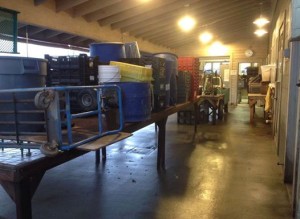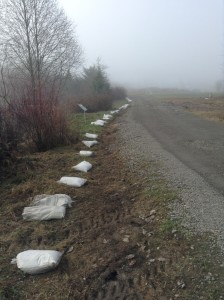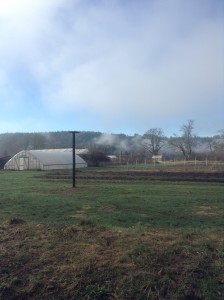Love? Hate? How do farmers feel about floods?
Floodplains are like a farmer’s slightly annoying best friend. Love ’em. Hate ’em. Either way, you have to deal with ’em.
Such is the life of a farmer living in a floodplain, and such is the current situation at Oxbow, where last week saw roughly 20% of our production fields submerged in Tuesday’s Snoqualmie River overflow. The deluge followed several days of heavy rain throughout the river valley and as far away as the Cascade Mountains, the eastern fringes of our watershed.
This flood was a big one, but not unprecedented or really even surprising. The valley’s “hundred-year floods”–those that entirely inundate the floodplain and leave farmers high and dry–are becoming more like two-year floods. Every valley farmer worth the name has a plan to protect the farm’s vitals from inundation. If you want to farm in a floodplain, then you have to farm in a floodplain.

The swollen Snoqualmie river on Wednesday, January 7th, the day after the flood.
The reliability of the flood season makes floods easier for Valley farmers to ride out, but it doesn’t make them any more fun to deal with. To be at Oxbow in the days between a flood’s forecast and its arrival is to see a flurry of farmers in frenzy. A flood of any real authority pushes water down our driveway in a river, completely submerges our parking lot and leaves several inches of standing water inside our barn–and in our case, the barn is not a junky red building. It houses everything on the farm that needs a house: Our administrative offices, shop, cold vegetable storage, CSA pack-out space and processing area. Anything small enough to get pushed around, light enough to float, or sensitive to water (ie, electronics) needs to be protected from the floodwaters. For big things like farm vehicles, this means being moved temporarily onto the farm pad, the small gravel patch occupying the highest point on the property. For everything else, the best we can do is fill up all the available table space.

Flood preparation in the processing area. Putting things on tables. Still effective in the digital age.
The driveway requires attention, too. Due to the sensitivity of the valley to paved surfaces, our driveway is gravel and, thus, susceptible to flowing water. Tarps secured with sandbags are our only defense, and they are not foolproof. Last week’s flood swept a section of driveway into the hedgerow.

Sandbags lie at the ready beside the driveway before the tarp was laid down.
Yet, despite the obvious irritations, there are things to be thankful for. The flood is, after all, the parent of the fertile farmland in our valley. Nutrient-rich floodwaters recharge our fields in their period of winter dormancy. One of the benefits of the flood will not even be felt until summertime–ground-nesting insect populations, some of whom are pests, are hurt by floods. Fewer eggs will hatch this spring because of the inundation of their nests.
These measurable benefits are supplemented by an less tangible, but equally uplifting one: A flooded farm is a truly beautiful place. It’s only a few days a year that a farmer is able to appreciate the reflection of the sky and the treeline in his fields and marvel at the ducks swimming where the broccoli used to grow.

Wednesday. A view west across our fields towards the late-afternoon sun.
A week later, all is back to normal. The sun has returned after seven days of fog and the garlic is still out there giving it the old college try. Somewhere in the distance, spring is approaching.

Glorious blue sky above the Kids’ Farm. Facing west.
